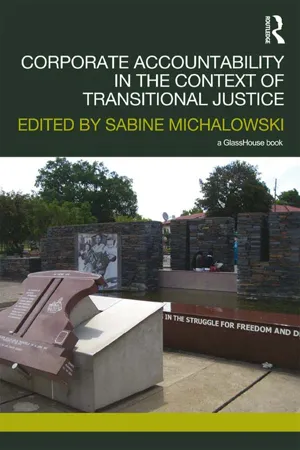
- 268 pages
- English
- ePUB (mobile friendly)
- Available on iOS & Android
Corporate Accountability in the Context of Transitional Justice
About This Book
Corporate Accountability in the Context of Transitional Justice explores how corporations can be held accountable for their role in past human rights violations when a country is making a transition from conflict or repression to peace and democracy. It breaks new ground in theorizing the linkages between the areas of transitional justice and corporate accountability and analyzing problems frequently arising where the two fields meet in practice, for example where the role of corporations in past human rights violations is examined by truth and reconciliation commissions or in the course of litigation.
The book provides an overview of the current trends in law and in legal and political discussion relating to both areas, as well as in-depth analysis of how tools of corporate accountability and transitional justice can complement each other in order to achieve the best outcomes for bringing justice to victims and lasting peace to societies. The authors bring extensive experience from diverse professional backgrounds and jurisdictions to provide the first sustained attempt to address this link. The book will be of interest to scholars, practitioners, policymakers and activists working in the areas of transitional justice; corporate accountability; and business and human rights.
Frequently asked questions
Information
Part 1 Transitional Justice and Corporate Accountability: Exploring Current Trends and Potential Linkages
Chapter 1 Linking Transitional Justice and Corporate Accountability
Introduction
Defining transitional justice
Processes of transitional justice
Table of contents
- Cover Page
- Halftitle Page
- Series Page
- Title Page
- Copyright Page
- Table of Contents
- Acknowledgments
- Contributors
- Introduction
- PART I Transitional Justice and Corporate Accountability: Exploring Current Trends and Potential Linkages
- PART II Linking Transitional Justice and Corporate Accountability: Examples and Case Studies
- Conclusion
- Index